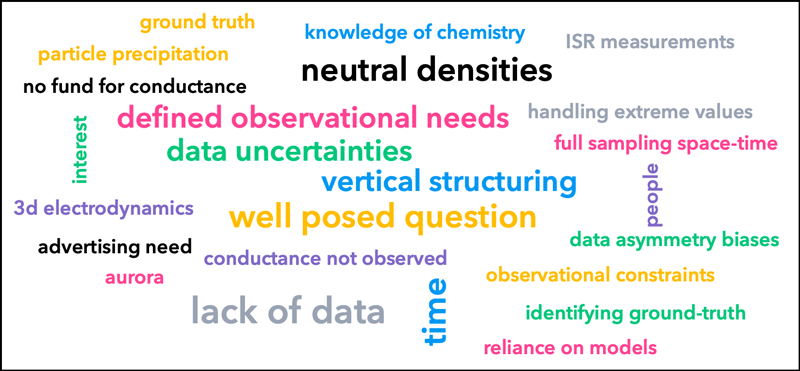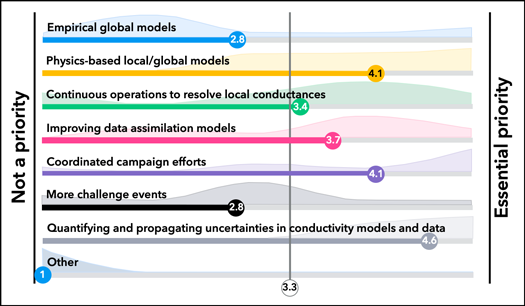The ionosphere, the ionized layer of Earth’s atmosphere far above the stratosphere, plays vital roles in many applications of modern technology. Radio signals travel through the ionosphere, for example, as do some spacecraft. Space weather events that direct energetic charged particles and radiation from the Sun toward Earth interact with the ionosphere, and even moderate space weather events can cause ionospheric conditions to change substantially. These changes affect the reliability of systems integral to society, such as GPS, telecommunications, power grid distribution, and even pipelines that transport oil, gas, and water (by causing corrosion of the pipes).
We have an opportunity to launch a collaborative space weather forecasting effort to facilitate the protection of critical infrastructure, national security assets, and the safety of civil aviation.
Ionospheric conductance—the ease with which electrical currents driven by space weather processes travel through the ionosphere—controls how severe the impacts of such events can be [Harel et al., 1981]. Without a thorough and systematic understanding of ionospheric conductance, which can vary spatially and over time, it is not possible to forecast and mitigate resulting disruptions. The challenges of achieving this understanding are too complicated for individual scientists or research groups to confront alone, so we need community-wide engagement.
We now have an opportunity to launch a collaborative forecasting effort to facilitate the protection of critical infrastructure, national security assets, and the safety of civil aviation. This past January, the U.S. House Committee on Science, Space, and Technology approved the Promoting Research and Observations of Space Weather to Improve the Forecasting of Tomorrow (PROSWIFT) Act, which entails establishing an interagency working group on space weather forecasting. Under this legislation, which is currently awaiting consideration by the full House of Representatives, roles and responsibilities would be assigned to various government agencies and departments as they work together on improving space weather research and forecasting.
Challenges of Modeling Ionospheric Conductance
A validation-related focus group has been an integral part of the National Science Foundation (NSF) Geospace Environment Modeling (GEM) community since 2005. As of 2019, Methods and Validation (M&V) became a standing committee to help guide and support various modeling efforts. The focus group held the Ionospheric Conductance Challenge Session at the mini-GEM meeting in December 2019 to solicit community input on the biggest challenges faced by researchers working to understand ionospheric conductance. Researchers identified challenges in three major categories in this open-format discussion: a lack of ground truthing, a lack of collaboration, and a lack of funding.

“Ground truth” often refers to information obtained by direct measurements, rather than from simulations. Having a designated ground truth data set is a critical component of validating and verifying physics-based models, calibrating instruments, and interpreting observed or simulated phenomena. However, because ionospheric conductance cannot be directly measured, researchers use measurements of other variables, statistical averages, and physical approximations to provide conductance estimates [Richmond and Maute, 2014]. These procedures introduce serious uncertainties into the final estimates because the proxy data sets used are sometimes incompatible with each other (e.g., if measurements were not taken at the same locations or times) and often are limited in spatial and temporal coverage.
Rewarding prosperous collaborations and the exchange of expertise among different groups are essential to moving the field forward.
Studies of ionospheric conductance involve tools and methods from various research areas that are traditionally separated. Rewarding prosperous collaborations and the exchange of expertise among these different groups are essential to moving the field forward. Interactions should be facilitated and encouraged between modelers and instrument scientists, between empiricists and first-principles modelers, between researchers who study the ionosphere and those who study the magnetosphere, and between physicists who study neutral particles and those who study plasmas. In the past, joint workshops between the GEM and NSF Coupling, Energetics and Dynamics of Atmospheric Regions communities have helped significantly in bringing together these communities, but further opportunities are needed.
Recognition of ionospheric conductance as a focused science objective is the most effective way to encourage the large-scale and cross-disciplinary collaboration needed to advance data-model validation efforts. Without this agency-level focus, at present, individual research groups study ionospheric conductance in different regions or under different drivers, with only the techniques and measurements already available to them. Therefore, determining conductance values and patterns often emerges as a side problem as researchers focus on more feasible scientific objectives in grant applications. Consequently, many researchers end up having insufficient resources to take on the challenges of studying conductance and have difficulty finding suitable collaborations to help them further their work.
High-Priority Tasks to Meet the Challenges
In the Ionospheric Conductance Challenge Session last December, participants identified three high-priority tasks for the community: quantifying uncertainties, coordinating efforts, and improving models.

The highest priority that the group identified is the need to systematically quantify uncertainties in the different conductance models and data sets available. The NASA Community Coordinated Modeling Center (CCMC) and the GEM M&V focus group are in ideal positions to lead such a cross-disciplinary effort. The M&V focus group organizes Ionospheric Conductance Challenge sessions at the GEM workshops, which provide a great venue for researchers to share their findings and form new collaborations. The CCMC provides online tools for a variety of different numerical models in addition to a data-model database for space weather events designated by the M&V focus group. Through this database, researchers can exchange measurement data and model results. Such platforms expedite uncertainty quantification and provide a basis for validation and verification processes.
A high-priority task is to compile a list of space weather events known as “challenge” or “campaign” events that researchers can work on to better detail ionospheric conductance profiles.
Another high-priority task is to compile a list of space weather events—known as “challenge” or “campaign” events for which there are multiple data sets available and space weather–studying spacecraft are in ideal positions to observe—that researchers can work on to better detail ionospheric conductance profiles. Tackling this challenge will require coordinated efforts and extensive input from researchers across a range of institutions and scientific fields. The M&V focus group aims to provide researchers with tools to better understand ionospheric conductance while increasing community engagement and collaboration through these coordinated efforts. Such studies pave the way for identifying the specific observational and computational requirements for improving our theoretical understanding.
The third high-priority task identified is to advance global and local physics-based models of conductance. The theoretical understanding achieved with these efforts benefits the public in the form of improved operational tools, in this case, space weather forecasting models. These models cannot be advanced without systematic validation and verification efforts that require ground truth, collaboration, and funding.
A Path to Progress
When ionospheric conductance is recognized as a key science topic, the community can make substantial progress in improving space weather forecasting models. Targeted solicitations and funding opportunities that foster collaborations between federal agencies, academia, and commercial companies will provide researchers with the resources they need. These steps are crucial for meeting the need for accurate, predictive ionospheric conductance modeling, which has long been a challenge in space weather forecasting.
Acknowledgments
This work was performed at the Jet Propulsion Laboratory, California Institute of Technology, under a contract with NASA.
References
Harel, M., et al. (1981), Quantitative simulation of a magnetospheric substorm: 1. Model logic and overview, J. Geophys. Res., 86(A4), 2,217–2,241, https://doi.org/10.1029/JA086iA04p02217.
Richmond, A. D., and A. Maute (2014), Ionospheric electrodynamics modeling, in Modeling the Ionosphere-Thermosphere System, Geophys. Monogr. Ser., vol. 201, edited by J. Huba, R. Schunk, and G. Khazanov, pp. 57–71, AGU, Washington, D.C., https://doi.org/10.1002/9781118704417.ch6.
Author Information
Doğacan Su Öztürk ([email protected]), Jet Propulsion Laboratory, California Institute of Technology, Pasadena; Katherine Garcia-Sage, NASA Goddard Space Flight Center, Greenbelt, Md.; and Hyunju Kim Connor, Geophysical Institute and Physics Department, University of Alaska Fairbanks
Citation:
Öztürk, D. S., K. Garcia-Sage, and H. K. Connor (2020), All hands on deck for ionospheric modeling, Eos, 101, https://doi.org/10.1029/2020EO144365. Published on 20 May 2020.
Text © 2020. The authors. CC BY-NC-ND 3.0
Except where otherwise noted, images are subject to copyright. Any reuse without express permission from the copyright owner is prohibited.

